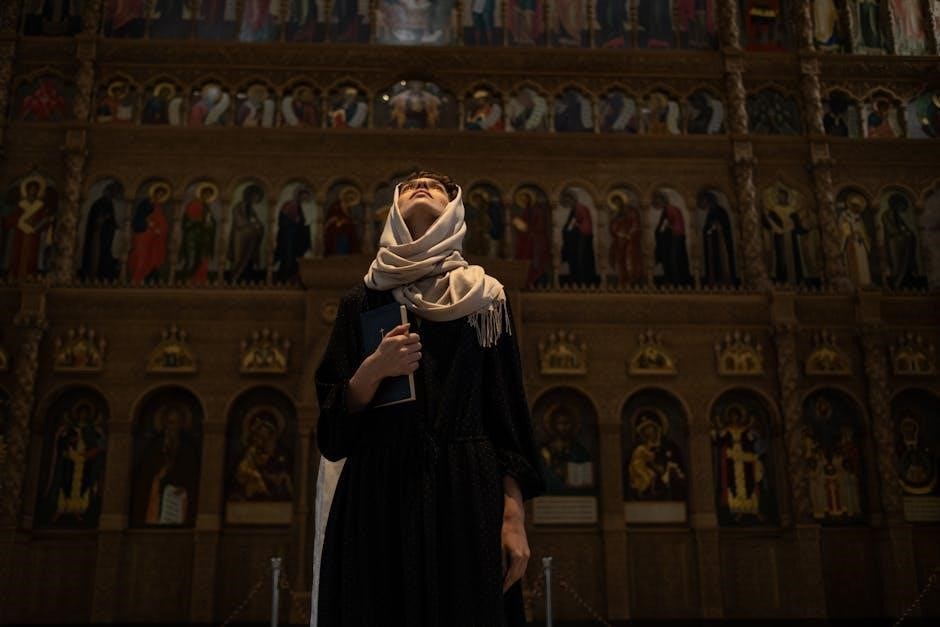The Poisonwood Bible, written by Barbara Kingsolver, is a captivating novel published in 1998. It explores the journey of the Price family in the Congo, blending cultural clashes and religious themes. The book’s non-linear narrative and multiple perspectives, including the symbolic poisonwood tree, have made it a favorite. Its PDF version is popular for its convenience and accessibility, allowing readers to engage with the story digitally.
1.1 Overview of the Book
The Poisonwood Bible by Barbara Kingsolver is a thought-provoking novel that follows the Price family as they relocate from the United States to the Congo in the late 1950s. The story unfolds through the perspectives of the four daughters and their mother, Orleanna, capturing the cultural and religious tensions they face. The novel explores themes of colonialism, faith, and identity, set against the backdrop of the Congolese jungle. Its non-linear narrative and vivid descriptions have made it a beloved and impactful read, with the PDF version offering a convenient way to experience this compelling tale.
1.2 Author Background: Barbara Kingsolver
Barbara Kingsolver, born in 1955 in Kentucky, is a renowned American novelist, poet, and essayist. She earned degrees in biology and creative writing, which heavily influence her lyrical prose. Kingsolver gained acclaim for her first novel, The Bean Trees, and continued to explore themes of social justice and environmentalism. Her work often reflects a deep connection to nature and humanity. The Poisonwood Bible solidified her reputation, earning her the National Book Foundation’s Medal for Distinguished Contribution to American Letters. Her writing is celebrated for its emotional depth and cultural insight, making her one of the most respected authors of her generation.
1.3 Historical Context and Setting
The Poisonwood Bible is set in the late 1950s and early 1960s, during the Congo’s tumultuous transition from Belgian colonial rule to independence. The story unfolds in a remote Congolese village, where Nathan Price, a Baptist missionary, relocates his family. The novel vividly portrays the cultural and political upheaval of the era, blending historical facts with fictional narrative. The Congolese environment, with its dense forests and vibrant wildlife, serves as a backdrop for the family’s struggles, while the poisonwood tree becomes a potent symbol of the region’s beauty and danger.

Plot and Structure
The Poisonwood Bible features a non-linear narrative divided into four books, each reflecting the voices of the Price sisters. The story explores their journey to the Congo, cultural clashes, and personal struggles, with the poisonwood tree and river serving as central symbols of transformation and tragedy.
2.1 The Four Books Within the Novel
The novel is divided into four books: Genesis, The Revelation, The Judges, and Bel and the Serpent. Each book represents a stage in the Price family’s journey, reflecting biblical themes. The structure mirrors the family’s evolving understanding of their mission and cultural surroundings. The books are narrated by different sisters, offering diverse perspectives. This division underscores the novel’s layered narrative, blending personal growth with broader themes of faith, identity, and cultural conflict. The four-book structure enhances the story’s depth and complexity.
2.2 The Non-Linear Narrative Style
The novel employs a non-linear narrative, weaving together multiple timelines and perspectives. The story unfolds through the voices of the Price family members, creating a layered exploration of their experiences. This structure mirrors the complexity of their journey, blending past and present to reveal deeper truths. The non-linear style enhances the emotional and thematic depth, allowing readers to piece together the family’s history and struggles from different angles, much like solving a puzzle. This approach underscores Kingsolver’s mastery of narrative technique and storytelling.
2.3 Key Plot Points and Turning Events
The novel’s pivotal moments include the Price family’s arrival in Kilanga, Nathan’s unyielding missionary zeal, and the community’s resistance. A turning point occurs when Nathan’s refusal to adapt leads to a tragic poisoning attempt. Orleanna’s ultimate departure with her daughters marks a emotional shift, while Rachel’s internal conflict and Leah’s ideological struggles further deepen the narrative. These events, intertwined with cultural tensions, shape the family’s fate and highlight the novel’s exploration of identity, faith, and resilience in a hostile environment.

Characters and Character Development
The Price family, including Nathan, Orleanna, and their daughters, undergo significant development as they navigate cultural clashes and personal struggles in the Congolese village.
3.1 The Price Family: Nathan, Orleanna, and Their Daughters
The Price family, led by the rigid and evangelical Nathan, relocates to the Congo with his wife Orleanna and their four daughters. Each daughter—Rachel, Leah, Adah, and Ruth May—embarks on a journey of self-discovery shaped by their father’s unwavering beliefs and the harsh realities of their new environment. Through their diverse perspectives, the novel explores themes of faith, identity, and resilience, offering a rich tapestry of character development and emotional depth.
3.2 The Role of Minor Characters in the Story
Minor characters in The Poisonwood Bible play pivotal roles in shaping the narrative and influencing the Price family. Local Congolese villagers, missionaries, and figures like the enigmatic Tata Kuvudundu add depth to the story. These characters often serve as catalysts for the family’s growth, challenging their beliefs and adapting to cultural differences. Their interactions highlight themes of colonialism, faith, and identity, enriching the novel’s exploration of human complexity and resilience in a foreign landscape.
3.4 The Symbolism of the Poisonwood Tree as a Character
The poisonwood tree serves as a profound symbolic character in the novel, embodying danger, transformation, and the clash of cultures. Its toxic sap mirrors the harmful consequences of Nathan’s rigid beliefs and colonial interference. The tree’s presence is both menacing and enduring, symbolizing the unyielding power of nature and the inevitable consequences of human actions. It also represents the family’s collective journey, as they navigate the toxicity of their own dynamics and the foreign environment. The tree’s silent yet pervasive influence underscores the novel’s themes of resilience and transformation.

Themes Explored in the Novel
The novel delves into themes of religion, cultural clashes, identity, and nature, exploring the complexities of human interaction with faith, environment, and personal growth in a foreign setting.
4.1 Religion and Its Impact on the Family
The novel explores the profound impact of religion on the Price family, particularly through Nathan’s rigid evangelical beliefs. His missionary zeal often clashes with the family’s well-being, creating tension and conflict. The Poisonwood Bible examines how religious devotion can both inspire and destroy, as Nathan’s unwavering faith leads to tragic consequences. The family’s experiences in the Congo reveal the complexities of religious conviction and its effects on personal relationships and cultural interactions, highlighting the delicate balance between faith and humanity. The PDF version of the book delves into these themes, offering readers a deeper understanding of the family’s spiritual journey and its repercussions.
4.2 Cultural Clashes Between Western and African Values
The Poisonwood Bible vividly portrays the cultural clashes between Western and African values, particularly through the Price family’s experiences in the Congo. Nathan’s rigid missionary mindset often conflicts with the local customs and traditions, leading to misunderstandings and tension. The novel highlights the imposition of Western beliefs on African societies, emphasizing the destructive consequences of cultural insensitivity. The PDF version of the book underscores these themes, illustrating the family’s struggles to adapt and the broader implications of colonialism and cultural imperialism, making it a poignant reflection on cross-cultural interactions. The story reveals the deep-seated differences in values and the challenges of bridging these gaps, ultimately questioning the ethics of imposing one’s beliefs on another culture. Through its exploration of these conflicts, the novel provides a powerful critique of colonialism and the clash of civilizations.
4.3 The Struggle for Identity and Independence
The Poisonwood Bible explores the intricate journey of self-discovery and independence within the Price family, particularly among the daughters. Each daughter grapples with her identity, shaped by their father’s rigid religious beliefs and the alienating African environment. The PDF version highlights their individual struggles, as they navigate cultural and personal expectations. Adah’s intellectual independence, Rachel’s quest for self-worth, and Leah’s ideological transformations are central themes. The novel vividly portrays how each character finds her voice, breaking free from oppressive norms to forge unique paths, reflecting the universal human quest for autonomy and self-definition.
4.4 The Role of Nature and the Environment
Nature plays a pivotal role in The Poisonwood Bible, symbolizing both beauty and danger. The Congolese jungle, with its lush landscapes and deadly creatures, serves as a backdrop for the family’s struggles. The poisonwood tree, central to the novel, represents the destructive power of unchecked forces. The garden, cultivated by the Prices, symbolizes hope and resilience, while the river embodies transformation and life’s flow. Kingsolver’s vivid descriptions highlight the interconnectedness of human and natural worlds, emphasizing nature’s indomitable presence and its impact on the characters’ lives and choices.

Symbolism and Motifs
The poisonwood tree symbolizes danger and sin, while the garden represents hope and destruction. The river embodies life’s transformation, ultimately intertwining these motifs to reflect the characters’ journeys.
5.1 The Poisonwood Tree as a Central Symbol
The poisonwood tree is a central symbol in the novel, representing danger, sin, and redemption. Its presence looms over the Price family, mirroring their turmoil and spiritual struggles. The tree’s toxic sap symbolizes the harmful consequences of Nathan’s rigid beliefs and the family’s clash with the African environment. It also serves as a metaphor for the characters’ moral growth and the consequences of their actions. The tree’s enduring presence underscores the novel’s themes of transformation and the intricate relationship between nature and humanity.
5.2 The Garden as a Symbol of Hope and Destruction
The garden in “The Poisonwood Bible” symbolizes both hope and destruction, reflecting the Price family’s struggles with their environment and beliefs. It represents the possibility of growth and renewal, as the family attempts to cultivate life in a foreign land. However, the garden also becomes a source of frustration and despair, as it withers under the harsh conditions and Nathan’s rigid ideology. This duality mirrors the family’s internal conflicts and their clash with the natural world, highlighting themes of resilience and the consequences of human interference with nature.
5.3 The River as a Symbol of Life and Transformation
The river in “The Poisonwood Bible” serves as a powerful symbol of life and transformation; It sustains the community, providing resources and connecting the villagers. Yet, its unpredictable nature mirrors the characters’ journeys, representing change and resilience. The river’s flow symbolizes the inevitability of transformation, as the Price family and others navigate cultural and personal shifts. Its presence underscores the interplay between life’s nurturing and disruptive forces, reflecting the novel’s broader themes of adaptation and the enduring impact of external influences on individual lives.

Awards and Recognition
The Poisonwood Bible was named the American Booksellers Book of the Year in 1998 and featured in the New York Times’ top ten books of 1998.
6.1 Major Literary Awards Won
The Poisonwood Bible earned significant literary acclaim, including the American Booksellers Book of the Year award in 1998. It also appeared in the New York Times’ top ten books of 1998. The novel was a finalist for the PEN/Faulkner Award in 1999, showcasing its critical reception. Its success extended to digital formats, with the PDF version remaining popular due to its accessibility and engaging narrative style. These accolades highlight the book’s enduring impact and its resonance with readers worldwide.

6.2 Critical Reception and Reviews
The Poisonwood Bible received widespread critical acclaim for its thought-provoking narrative and vivid character development. Critics praised its exploration of cultural clashes and religious themes, with many highlighting its lyrical prose. The novel’s multiple perspectives were particularly noted for their depth and emotional resonance. While it was overlooked for the PEN/Faulkner Award in 1999, its inclusion in the New York Times’ top ten books of 1998 underscored its literary significance. The PDF version has further enhanced its accessibility, making it a favorite among modern readers.

Writing Style and Narrative Techniques
Kingsolver’s lyrical prose and biblical allusions enrich the narrative, while multiple voices add depth. The PDF format preserves her descriptive style, enhancing accessibility without losing literary essence.
7.1 Multiple Narrative Voices and Perspectives
The novel employs a unique narrative structure, with each of the four Price daughters and their mother offering distinct perspectives. This technique allows readers to experience the story through varied lenses, enriching the exploration of themes like cultural clashes and personal growth. The PDF version of the book maintains this complexity, ensuring that the layered storytelling remains intact. Kingsolver’s use of multiple voices creates a dynamic and immersive reading experience, highlighting the individual struggles and transformations of each character.
7.2 The Use of Biblical Allusions
The novel is rich with Biblical allusions, reflecting its themes of faith and redemption. The book’s structure, divided into sections like Genesis and Revelation, mirrors the Bible, while the poisonwood tree symbolizes sin and redemption. Kingsolver’s use of these allusions deepens the narrative, drawing parallels between the Price family’s journey and biblical stories. The PDF version retains these layers, enhancing the reader’s connection to the text’s spiritual and moral explorations.
7.3 Kingsolver’s Lyrical and Descriptive Prose
Barbara Kingsolver’s prose in The Poisonwood Bible is renowned for its lyrical and descriptive quality. Her vivid portrayal of the Congolese landscape immerses readers in the setting, blending beauty with danger. Kingsolver’s language is both poetic and evocative, capturing the emotional depth of her characters and their struggles. The PDF version of the book preserves this richness, allowing readers to experience the intricate details and sensory descriptions that bring the story to life. Her writing style enhances the novel’s emotional and cultural resonance.

Cultural and Social Relevance
The novel explores colonialism, feminism, and missionary impact, resonating with global issues. Its digital format in PDF increases accessibility, spreading its powerful message to diverse audiences worldwide.
8.1 The Novel’s Portrayal of Colonialism
The Poisonwood Bible critiques colonialism through the Price family’s experiences in the Congo. Nathan’s missionary work reflects cultural imperialism, imposing Western beliefs on African traditions. The novel highlights the clash between Western and African values, showing the disruptive impact of colonialism. Missionary efforts, though well-intentioned, often led to exploitation and cultural erasure. The novel’s PDF version spreads this critique widely, emphasizing the need for cultural sensitivity and understanding. Kingsolver’s portrayal remains a powerful commentary on colonialism’s legacy.
8.2 Feminism and the Role of Women in the Story
The Poisonwood Bible explores feminist themes through its female characters, particularly Orleanna and her daughters. Each woman navigates patriarchal constraints, seeking independence and identity. The novel highlights their resilience and growth, challenging traditional gender roles. The PDF version’s accessibility has broadened the reach of these themes, sparking discussions on women’s empowerment. Kingsolver’s portrayal of strong, complex female characters remains a significant aspect of the book’s appeal and relevance in modern feminist discourse.
8.3 The Impact of Missionary Work on Indigenous Communities
The Poisonwood Bible critiques missionary work’s effects on indigenous communities. Nathan Price’s rigid evangelical efforts disrupt the local culture, highlighting the tension between religious zeal and cultural sensitivity. The novel portrays the villagers’ resistance and the unintended consequences of imposing foreign beliefs. The PDF version’s accessibility has amplified discussions on colonialism and cultural interference, revealing the book’s enduring relevance to global issues of cultural exchange and the ethics of missionary work.

The PDF Version and Its Popularity
The PDF version of The Poisonwood Bible has gained significant popularity due to its convenience and accessibility. Readers appreciate the ease of carrying the novel digitally.
Online platforms have further boosted its reach, making it a favorite among modern readers who prefer digital formats for their portability and ease of access.
9.1 Reasons for the Book’s Digital Popularity
The PDF version of The Poisonwood Bible has surged in popularity due to its convenience and accessibility. Readers appreciate the ease of carrying the novel digitally across various devices, making it ideal for travel and space-conscious readers. The affordability and often free availability of the PDF attract budget-conscious readers. Additionally, the book’s critical acclaim and Barbara Kingsolver’s reputation drive its demand. Online platforms facilitate quick purchases and downloads, enhancing its reach. The PDF’s well-formatted structure and annotative features also appeal to academic users, while its eco-friendly nature resonates with environmentally conscious readers. Effective marketing on major platforms further boosts its popularity, ensuring its accessibility and appeal to a broad audience.
9.2 The Convenience of the PDF Format
The PDF format of The Poisonwood Bible offers unparalleled convenience, allowing readers to access the novel anytime, anywhere; Its digital nature eliminates the need for physical storage, making it ideal for travelers and those with limited space. The PDF is easily sharable and compatible with various devices, ensuring a seamless reading experience. Additionally, the format preserves the book’s original layout and typography, enhancing readability. This accessibility has significantly contributed to the book’s widespread popularity and enduring appeal in the digital age.
9.3 The Role of Online Platforms in Promoting the Book
Online platforms have played a crucial role in promoting The Poisonwood Bible by Barbara Kingsolver. Social media discussions, online reviews, and e-commerce sites like Amazon have increased its visibility. The availability of the PDF version on these platforms has made it easily accessible to a global audience. Additionally, reading groups and forums often recommend the book, further boosting its popularity. The digital age has ensured that Kingsolver’s work remains relevant and widely read, thanks to the reach and convenience provided by online platforms.
The Poisonwood Bible remains a timeless exploration of cultural clashes, religious zeal, and personal identity. Its PDF version ensures convenient access, keeping Kingsolver’s profound story relevant digitally.
10.1 Final Thoughts on the Novel’s Significance
The Poisonwood Bible is a profound exploration of cultural clashes, religious zeal, and personal identity. Its vivid storytelling and complex characters resonate deeply, offering insights into colonialism and feminism. The novel’s themes of family, resilience, and transformation are timeless; The PDF version has made it accessible to a wider audience, ensuring its relevance in the digital age. Kingsolver’s work remains a significant contribution to contemporary literature, cherished for its emotional depth and thought-provoking narrative.
10.2 The Lasting Legacy of “The Poisonwood Bible”
The Poisonwood Bible has left an indelible mark on literature, celebrated for its rich storytelling and nuanced exploration of cultural and familial dynamics. Its themes of colonialism, spirituality, and personal identity continue to resonate with readers. The novel’s popularity endures, with its PDF version making it easily accessible to global audiences. Kingsolver’s masterful prose and the book’s universal themes ensure its lasting legacy as a significant work of contemporary fiction, cherished for its emotional and intellectual depth.